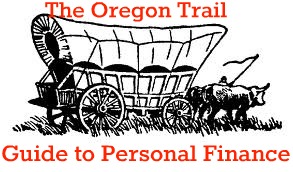As we enter part 2 of The Oregon Trail Guide to Personal Finance, take some time (if you haven’t already) to review part 1.
Now that you’ve figured out how to acquire the money, items and support system you need to begin your financial Oregon Trail, it’s time to learn how to not get screwed at the store. After all, you’ve worked really hard to get to this point (or maybe not hard at all and it’s just something that happened) and you don’t want to squander those dollars (or get taken in by shady shop owners. Like the guys who own the general stores in the game. They? Are shysters). And since shopping is pretty much unavoidable, particularly shopping for necessities like food and clothes, it’s best to have a strategy each time you walk into the store.
Here are some ideas for creating that strategy:
Make mindful, careful purchases
Frivolous purchases are the bane to every budget. We all want the latest, fanciest ox or wagon cover and honestly, who doesn’t want to buy that mysterious feather just because? I know I certainly do. But having those things won’t always get me to my destination, especially if they use up all the money I have for necessities and I have to starve or worry about poison berries that I had to pick from the side of road because I ran out of money to buy quality, safe food. And that fancy ox? Is it really going to do a better job of getting me to my destination than the regular, standard ox (ox, by the way, is my metaphor for car). The best way to combat buying useless but fun and fancy products is to walk into the store having researched and thought carefully about what you want to buy and only look for those items that fit into those criteria. And your budget.
By carefully planning your purchases and being mindful of their quality, durability, and price, you can maximize your purchasing power and not get blinded by shiny objects.
Stockpile when possible
Stockpiling like a hoarder is never recommended. Particularly if you’re traveling in a very small, cramped wagon with 4 other people (and the occasional hitchhiker). But having a few extra supplies of items you need and/or frequently use is a good idea, especially if a) you can get them for a good price and b) you have the room to store them. For instance, when on the trail, my party likes to contract cholera. I know this after playing it 6000 times. So, when I have the money, I purchase numerous doses of chicken broth, the antidote to cholera (I love 1800s medicine). This prevents me from having to pay extra money at a convenience store (read: store on the trail, not at a fort) when my child gets sick. Plus, the doses don’t take up a ton of room so I can easily store them in a backpack with the feathers, mushrooms, and rope I’ve managed to collect along the way.
Let me be clear: going into debt to stockpile is not recommended. Only buy more than you need to survive when you have the money. And the room. There is no need to create extra space or create crowded conditions just so you can have that extra ax or roll of toilet paper.
Fix what you have before you buy new
When something breaks down, most people’s first instinct is to throw it out and buy something new. But when you’re traveling the treacherous Oregon Trail and your wagon wheel breaks and a new one is going to cost you 80 coins and you only have 60, there’s really only two options. The first, to quit traveling and just settle where you are, is not really a desirable choice (plus, it defeats the purpose of the game). The second choice is to repair the wheel. You can run to the store and purchase a repair kit for 8 coins to fix the wheel yourself. Or pay someone 20 coins to fix it for you. Either way, it’s cheaper than buying new. And who knows, that 40 coins you’ve saved yourself might just pay your fare on a ferry or buy some food at the next fort.
I do recognize and accept that it is not always possible to repair items. For example, if your wagon goes up in flames or a bear attacks and murders your oxen, you don’t have a choice but to buy new. And that’s fine. Just take care to make smart rather than emotional purchases during these times.
One final tip: look for deals.
I mean, who doesn’t love to shop for a good bargain? And on the trail, there are good bargains to be found. Besides waiting until you get to the stores at the forts to save 20% on your purchases, you can trade supplies for food, barter items for wagon parts, and even pawn items you’re not using at the general stores to earn extra cash. It’s a pretty great way to get what you need by getting rid of items you don’t want.
In real life, this can mean comparing prices at different stores, selling items on eBay or trading services with a friend (cooking meals for babysitting). If you’re short on cash, there are ways (legal ways) to earn the money to purchase those necessities.
Phew! That’s a lot to remember. But by employing these tips, it is possible not to drain your bank account when you go shopping. After all, who doesn’t love to shop and still come home with cash in her wallet (or coins in her purse)?
If you liked this, please come back tomorrow when we talk about strategies for surviving the trail.


